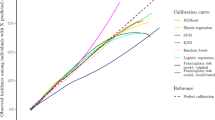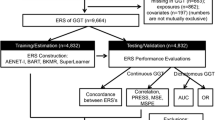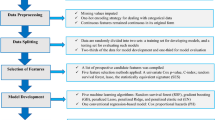Abstract
Hypertension is a chronic cardiovascular disease characterized by elevated blood pressure that can lead to a number of complications. There is evidence that the numerous environmental substances to which humans are exposed facilitate the emergence of diseases. In this work, we sought to investigate the relationship between exposure to environmental contaminants and hypertension as well as the predictive value of such exposures. The National Health and Nutrition Survey (NHANES) provided us with the information we needed (2005–2012). A total of 4492 participants were included in our study, and we incorporated more common environmental chemicals and covariates by feature selection followed by regularized network analysis. Then, we applied various machine learning (ML) methods, such as extreme gradient boosting (XGBoost), random forest classifier (RF), logistic regression (LR), multilayer perceptron (MLP), and support vector machine (SVM), to predict hypertension by chemical exposure. Finally, SHapley Additive exPlanations (SHAP) were further applied to interpret the features. After the initial feature screening, we included a total of 29 variables (including 21 chemicals) for ML. The areas under the curve (AUCs) of the five ML models XGBoost, RF, LR, MLP, and SVM were 0.729, 0.723, 0.721, 0.730, and 0.731, respectively. Butylparaben (BUP), propylparaben (PPB), and 9-hydroxyfluorene (P17) were the three factors in the prediction model with the highest SHAP values. Comparing five ML models, we found that environmental exposure may play an important role in hypertension. The assessment of important chemical exposure parameters lays the groundwork for more targeted therapies, and the optimized ML models are likely to predict hypertension.






Similar content being viewed by others
Data Availability
The datasets analyzed during the current study are available in the NHANES repository (https://wwwn.cdc.gov/nchs/nhanes/Default.aspx).
Abbreviations
- AUC :
-
Area under the curve
- BMI :
-
Body mass index
- BP3 :
-
Benzophenone-3
- BPA :
-
Bisphenol A
- BUP :
-
Butylparaben
- Cd :
-
Cadmium
- COT :
-
Cotinine
- DBP :
-
Diastolic blood pressure
- EPB :
-
Ethylparaben
- Hg :
-
Mercury
- LOD :
-
The limit of detection
- LR :
-
Logistic regression
- MBzP :
-
Monobenzyl phthalate
- MCNP :
-
Mono-carboxynonyl phthalate
- MCOP :
-
Mono-carboxyoctyl phthalate
- MCPP :
-
Mono-(3-carboxypropyl) phthalate
- MECPP :
-
Mono-2-ethyl-5-carboxypentyl phthalate
- MEHHP :
-
Mono-(2-ethl-5-hydrxhxyl) phthalate
- MEHP :
-
Mono-(2-ethyl)-hexyl phthalate
- MEOHP :
-
Mono-(2-ethyl-5-oxohexyl) phthalate
- MEP :
-
Monoethyl phthalate
- MiBP :
-
Monoisobutyl phthalate
- MiNP :
-
Monoisononyl phthalate
- ML :
-
Machine learning
- MLP :
-
Multilayer perceptron
- MMP :
-
Mono-n-methyl phthalate
- MnBP :
-
Phthalates mono-n-butyl phthalate
- MPB :
-
Methylparaben
- MVPA :
-
Moderate-to-vigorous physical activity
- NCHS :
-
The National Center for Health Statistics
- NHANES :
-
The National Health and Nutrition Survey
- P01 :
-
1-Hydroxynaphthalene
- P02 :
-
2-Hydroxynaphthalene
- P03 :
-
3-Hydroxyfluorene
- P04 :
-
2-Hydroxyfluorene
- P05 :
-
3-Hydroxyphenanthrene
- P06 :
-
1-Hydroxyphenanthrene
- P07 :
-
2-Hydroxyphenanthrene
- P10 :
-
1-Hydroxypyrene
- P17 :
-
9-Hydroxyfluorene
- PAH :
-
Polyaromatic hydrocarbons
- Pb :
-
Lead
- PIR :
-
Poverty income ratio
- PPB :
-
Propylparaben
- RF :
-
Random forest classifier
- SBP :
-
Systolic blood pressure
- SHAP :
-
SHapley Additive exPlanations
- SVM :
-
Support vector machine
- TCS :
-
Triclosan
- XGBoost :
-
Extreme gradient boosting
- 2,4-DCP :
-
2,4-Dichlorophenol
- 2,5-DCP :
-
2,5-Dichlorophenol
References
Aramjoo H, Arab-Zozani M, Feyzi A, Naghizadeh A, Aschner M, Naimabadi A, Farkhondeh T, Samarghandian S (2022) The association between environmental cadmium exposure, blood pressure, and hypertension: a systematic review and meta-analysis. Environ Sci Pollut Res Int 29:35682–35706
Bae S, Samuels JA, Flynn JT, Mitsnefes MM, Furth SL, Warady BA, Ng DK (2022) Machine learning-based prediction of masked hypertension among children with chronic kidney disease. Hypertension 79:2105–2113
Carnethon MR, Evans NS, Church TS, Lewis CE, Schreiner PJ, Jacobs DR Jr, Sternfeld B, Sidney S (2010) Joint associations of physical activity and aerobic fitness on the development of incident hypertension: coronary artery risk development in young adults. Hypertension 56:49–55
Chen T, Guestrin C (2016) XGBoost: A scalable tree boosting system. Proceedings of the 22nd acm sigkdd international conference on knowledge discovery and data mining 2016:785–794
Chowdhury MZI, Leung AA, Sikdar KC, O’Beirne M, Quan H, Turin TC (2022) Development and validation of a hypertension risk prediction model and construction of a risk score in a Canadian population. Sci Rep 12:12780
Desvergne B, Feige JN, Casals-Casas C (2009) PPAR-mediated activity of phthalates: a link to the obesity epidemic? Mol Cell Endocrinol 304:43–48
Forman JP, Stampfer MJ, Curhan GC (2009) Diet and lifestyle risk factors associated with incident hypertension in women. JAMA 302:401–411
Garner RE, Levallois P (2017) Associations between cadmium levels in blood and urine, blood pressure and hypertension among Canadian adults. Environ Res 155:64–72
Houston MC (2007) The role of mercury and cadmium heavy metals in vascular disease, hypertension, coronary heart disease, and myocardial infarction. Altern Ther Health Med 13:S128–S133
Hung MH, Shih LC, Wang YC, Leu HB, Huang PH, Wu TC, Lin SJ, Pan WH, Chen JW, Huang CC (2021) Prediction of masked hypertension and masked uncontrolled hypertension using machine learning. Front Cardiovasc Med 8:778306
Jacobs L, Buczynska A, Walgraeve C, Delcloo A, Potgieter-Vermaak S, Van Grieken R, Demeestere K, Dewulf J, Van Langenhove H, De Backer H, Nemery B, Nawrot TS (2012) Acute changes in pulse pressure in relation to constituents of particulate air pollution in elderly persons. Environ Res 117:60–67
Jeong YW, Jung Y, Jeong H, Huh JH, Sung KC, Shin JH, Kim HC, Kim JY, Kang DR (2022) Prediction model for hypertension and diabetes mellitus using Korean public health examination data (2002–2017). Diagnostics 12:1967
Kaur S, Garg N, Rubal R, Dhiman M (2022) Correlative study on heavy metal-induced oxidative stress and hypertension among the rural population of Malwa Region of Punjab, India. Environ Sci Pollut Res Int 29:90948–90963
Lawlor DA, Nordestgaard BG, Benn M, Zuccolo L, Tybjaerg-Hansen A, Davey Smith G (2013) Exploring causal associations between alcohol and coronary heart disease risk factors: findings from a Mendelian randomization study in the Copenhagen General Population Study. Eur Heart J 34:2519–2528
Leung AA, Bushnik T, Hennessy D, McAlister FA, Manuel DG (2019) Risk factors for hypertension in Canada. Health Rep 30:3–13
Lim SS, Vos T, Flaxman AD, Danaei G, Shibuya K, Adair-Rohani H, Amann M, Anderson HR, Andrews KG, Aryee M, Atkinson C, Bacchus LJ, Bahalim AN, Balakrishnan K, Balmes J, Barker-Collo S, Baxter A, Bell ML, Blore JD, Blyth F, Bonner C, Borges G, Bourne R, Boussinesq M, Brauer M, Brooks P, Bruce NG, Brunekreef B, Bryan-Hancock C, Bucello C, Buchbinder R, Bull F, Burnett RT, Byers TE, Calabria B, Carapetis J, Carnahan E, Chafe Z, Charlson F, Chen H, Chen JS, Cheng AT, Child JC, Cohen A, Colson KE, Cowie BC, Darby S, Darling S, Davis A, Degenhardt L, Dentener F, Des Jarlais DC, Devries K, Dherani M, Ding EL, Dorsey ER, Driscoll T, Edmond K, Ali SE, Engell RE, Erwin PJ, Fahimi S, Falder G, Farzadfar F, Ferrari A, Finucane MM, Flaxman S, Fowkes FG, Freedman G, Freeman MK, Gakidou E, Ghosh S, Giovannucci E, Gmel G, Graham K, Grainger R, Grant B, Gunnell D, Gutierrez HR, Hall W, Hoek HW, Hogan A, Hosgood HD 3rd, Hoy D, Hu H, Hubbell BJ, Hutchings SJ, Ibeanusi SE, Jacklyn GL, Jasrasaria R, Jonas JB, Kan H, Kanis JA, Kassebaum N, Kawakami N, Khang YH, Khatibzadeh S, Khoo JP, Kok C, Laden F et al (2012) A comparative risk assessment of burden of disease and injury attributable to 67 risk factors and risk factor clusters in 21 regions, 1990–2010: a systematic analysis for the Global Burden of Disease Study 2010. Lancet 380:2224–2260
Lu L, Ni R (2023) Association between polycyclic aromatic hydrocarbon exposure and hypertension among the U.S. adults in the NHANES 2003–2016: A cross-sectional study. Environ Res 217:114907
Lundberg S, Lee SI (2017) A unified approach to interpreting model predictions. Proceedings of the 31st International Conference on Neural Information Processing Systems 2017:4768–4777
Mateos A, Dopazo J, Jansen R, Tu Y, Gerstein M, Stolovitzky G (2002) Systematic learning of gene functional classes from DNA array expression data by using multilayer perceptrons. Genome Res 12:1703
Miao H, Liu Y, Tsai TC, Schwartz J, Ji JS (2020) Association between blood lead level and uncontrolled hypertension in the US population (NHANES 1999–2016). J Am Heart Assoc 9:e015533
Mills KT, Bundy JD, Kelly TN, Reed JE, Kearney PM, Reynolds K, Chen J, He J (2016) Global disparities of hypertension prevalence and control: a systematic analysis of population-based studies from 90 countries. Circulation 134:441–450
Mills KT, Stefanescu A, He J (2020) The global epidemiology of hypertension. Nat Rev Nephrol 16:223–237
Nash D, Magder L, Lustberg M, Sherwin RW, Rubin RJ, Kaufmann RB, Silbergeld EK (2003) Blood lead, blood pressure, and hypertension in perimenopausal and postmenopausal women. JAMA 289:1523–1532
Rahman HH, Niemann D, Munson-McGee SH (2022) Environmental exposure to metals and the risk of high blood pressure: a cross-sectional study from NHANES 2015–2016. Environ Sci Pollut Res Int 29:531–542
Sonne-Holm S, Sørensen TI, Jensen G, Schnohr P (1989) Independent effects of weight change and attained body weight on prevalence of arterial hypertension in obese and non-obese men. BMJ 299:767–770
Steyerberg EW, Eijkemans MJ, Harrell FE Jr, Habbema JD (2000) Prognostic modelling with logistic regression analysis: a comparison of selection and estimation methods in small data sets. Stat Med 19:1059–1079
Suykens JAK, Vandewalle J (1999) Least squares support vector machine classifiers. Neural Process Lett 9:293–300
Tran NK, Albahra S, May L, Waldman S, Crabtree S, Bainbridge S, Rashidi H (2021) Evolving applications of artificial intelligence and machine learning in infectious diseases testing. Clin Chem 68:125–133
Trasande L, Sathyanarayana S, Spanier AJ, Trachtman H, Attina TM, Urbina EM (2013) Urinary phthalates are associated with higher blood pressure in childhood. J Pediatr 163:747–53.e1
Trasande L, Zoeller RT, Hass U, Kortenkamp A, Grandjean P, Myers JP, DiGangi J, Bellanger M, Hauser R, Legler J, Skakkebaek NE, Heindel JJ (2015) Estimating burden and disease costs of exposure to endocrine-disrupting chemicals in the European union. J Clin Endocrinol Metab 100:1245–1255
Vaziri ND (2008) Mechanisms of lead-induced hypertension and cardiovascular disease. Am J Physiol Heart Circ Physiol 295:H454–H465
Wang NY, Young JH, Meoni LA, Ford DE, Erlinger TP, Klag MJ (2008) Blood pressure change and risk of hypertension associated with parental hypertension: the Johns Hopkins Precursors Study. Arch Intern Med 168:643–648
Wang F, Wang Y, Wang Y, Jia T, Chang L, Ding J, Zhou L (2022) Urinary polycyclic aromatic hydrocarbon metabolites were associated with hypertension in US adults: data from NHANES 2009–2016. Environ Sci Pollut Res Int 29:80491–80501
Whelton PK, Carey RM, Aronow WS, Casey DE Jr, Collins KJ, Dennison Himmelfarb C, DePalma SM, Gidding S, Jamerson KA, Jones DW, MacLaughlin EJ, Muntner P, Ovbiagele B, Smith SC Jr, Spencer CC, Stafford RS, Taler SJ, Thomas RJ, Williams KA Sr, Williamson JD, Wright JT Jr (2018) 2017 ACC/AHA/AAPA/ABC/ACPM/AGS/APhA/ASH/ASPC/NMA/PCNA Guideline for the prevention, detection, evaluation, and management of high blood pressure in adults: a report of the American College of Cardiology/American Heart Association Task Force on Clinical Practice Guidelines. J Am Coll Cardiol 71:e127–e248
Wu W, Jiang S, Zhao Q, Zhang K, Wei X, Zhou T, Liu D, Zhou H, Zeng Q, Cheng L, Miao X, Lu Q (2018) Environmental exposure to metals and the risk of hypertension: a cross-sectional study in China. Environ Pollut 233:670–678
Yang S, Taylor D, Yang D, He M, Liu X, Xu J (2021) A synthesis framework using machine learning and spatial bivariate analysis to identify drivers and hotspots of heavy metal pollution of agricultural soils. Environ Pollut 287:117611
Zhou S, Lu H, Zhang X, Shi X, Jiang S, Wang L, Lu Q (2022) Paraben exposures and their interactions with ESR1/2 genetic polymorphisms on hypertension. Environ Res 213:113651
Acknowledgements
This work was supported by the Heilongjiang Provincial Science and Technology Department (2022ZXJ03C05), the Military Healthcare Program (19BJZ24), and the National Natural Science Foundation of China (82271770).
Author information
Authors and Affiliations
Contributions
Shanshan Liu: formal analysis and writing—original draft; Lin Lu: methodology and formal analysis; Fei Wang: formal analysis; Bingqing Han: data curation; Lei Ou: writing—review and editing. Xiangyang Gao: data curation; Yi Luo: formal analysis; Wenjing Huo: data curation and methodology; Qiang Zeng: project administration and writing—review and editing.
Corresponding author
Ethics declarations
Ethical approval
Approval from the ethical board for this study was not required because of the public nature of all the data.
Consent to participate
Not applicable.
Consent for publication
Not applicable.
Competing interests
The authors declare no competing interests.
Additional information
Responsible Editor: Lotfi Aleya
Publisher's Note
Springer Nature remains neutral with regard to jurisdictional claims in published maps and institutional affiliations.
Supplementary Information
Below is the link to the electronic supplementary material.
Rights and permissions
Springer Nature or its licensor (e.g. a society or other partner) holds exclusive rights to this article under a publishing agreement with the author(s) or other rightsholder(s); author self-archiving of the accepted manuscript version of this article is solely governed by the terms of such publishing agreement and applicable law.
About this article
Cite this article
Liu, S., Lu, L., Wang, F. et al. Building a predictive model for hypertension related to environmental chemicals using machine learning. Environ Sci Pollut Res 31, 4595–4605 (2024). https://doi.org/10.1007/s11356-023-31384-w
Received:
Accepted:
Published:
Issue Date:
DOI: https://doi.org/10.1007/s11356-023-31384-w




